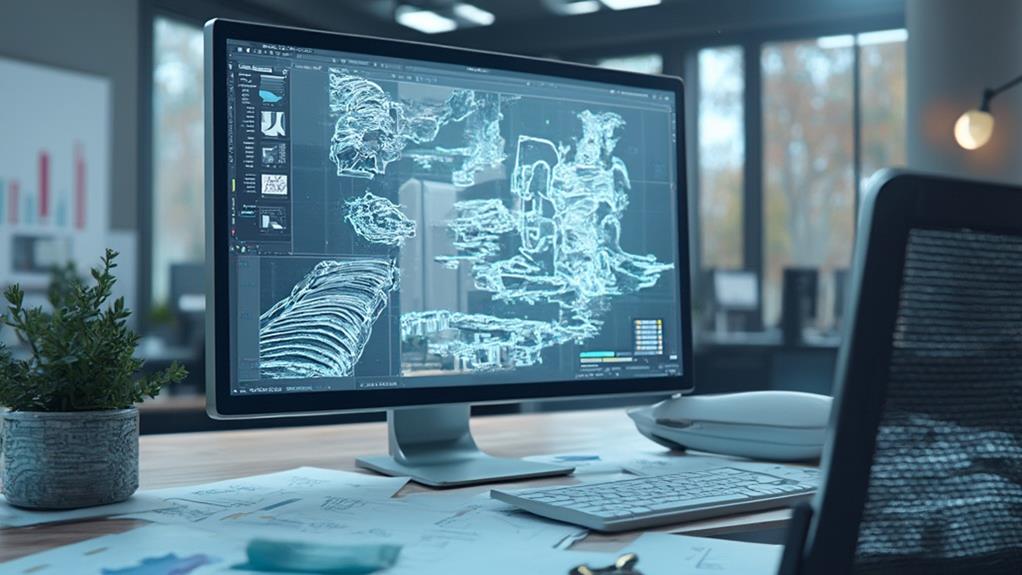In 2023, top retaining wall engineering software emerges as essential tools equipped with advanced modeling and calculation capabilities, tailored to gravity, cantilever, and anchored wall designs. The sophisticated interfaces provide logical and coherent navigation with customizable dashboards to align with specific engineering workflows. A key strength is their interoperability, allowing seamless integration with existing engineering platforms, while offering compatibility with a broad range of file formats and cloud-based solutions for enhanced collaboration. Subscription models offer cost efficiency, catering to varying project scales. With these features, these programs support precise design simulations and innovative engineering solutions, prompting further exploration of their extensive offerings.
Table of Contents
ToggleWalls Contractor Highlights
- Leading software includes advanced design tools for modeling various wall types, enhancing engineering precision and creativity.
- Robust calculation engines optimize design accuracy based on geotechnical data and complex load combinations.
- Leading platforms offer seamless interoperability with other engineering software for improved workflow integration.
- Modular licensing and scalable subscription options ensure affordable access to diverse functionalities tailored to firm sizes.
- User interfaces prioritize intuitive navigation and customizable dashboards, enhancing productivity and user satisfaction.
Top-Ranked Engineering Software

Evaluating top-ranked engineering software for retaining walls involves a thorough analysis of key features that enhance the design process, such as advanced calculation capabilities and customization options tailored to diverse engineering requirements. Software that can handle various wall materials like boulder, limestone, and fieldstone is particularly valuable for engineers working on diverse projects.
The ability to integrate site-specific conditions and local building codes into the design process is also essential. Equally important is the user interface efficiency, which determines ease of navigation and usability, thereby influencing productivity and user satisfaction.
Additionally, considerations of cost and accessibility play a pivotal role, as they impact both the long-term financial investment for organizations and the software's availability to a wider range of users, from small firms to large corporations.
Key Features Comparison
Selecting the ideal retaining wall engineering software can greatly impact the efficiency and accuracy of structural designs. Each top-ranked software offers a distinct set of key features tailored to meet the diverse needs of engineers. In this discussion, we'll focus on comparing essential features like design capabilities, calculation accuracy, and integration with other engineering tools, as these factors are indispensable in ensuring reliable results and enhancing user experience.
Advanced design capabilities allow engineers to model various wall types, including gravity, cantilever, and anchored walls. This flexibility is often complemented by robust calculation engines that provide precise analysis based on geotechnical data and load combinations. Additionally, effective software should offer interoperability with other engineering platforms, ensuring a seamless workflow that incorporates soil condition analysis, structural load assessment, and compliance with international design codes.
For professionals aiming to elevate their practice, selecting software that facilitates customization through parametric modeling supports creative problem-solving and tailored design solutions. Furthermore, expansive libraries of materials and construction methods, coupled with intuitive data input and output interfaces, enhance the practical applicability of engineering solutions. Consequently, mastering the features of top engineering software fosters a collaborative environment where precision and innovation thrive.
User Interface Efficiency
Traversing through complex engineering software can be a challenge, but top-ranked systems simplify this process with streamlined user interface efficiency. These advanced platforms prioritize intuitive design, ensuring that structural engineers can readily access powerful tools without unnecessary barriers. By presenting information in a coherent manner and employing logical flow, these interfaces empower users to focus on critical tasks rather than wrestling with cumbersome navigation. Such efficiency is achieved through careful attention to layout, where the intricacies of data input and analysis are seamlessly integrated into the software's fabric.
Moreover, a hallmark of these systems is their adaptability, offering customizable dashboards that reflect the unique workflows of individual engineers or firms, thereby fostering a sense of control and ownership. This flexibility not only accelerates task execution but also nurtures an environment where creativity and precision coexist.
Enhanced with an aesthetic that resonates with professional sensibilities, these interfaces offer visual clarity and structure, which align installation complexity with user ambition.
Collectively, these elements contribute to an experience that respects and elevates the professional expertise of engineers, ensuring they are supported by a digital workspace that mirrors their pursuit of excellence. In this way, software transcends function, becoming an integral tool in the modern engineer's arsenal.
Cost and Accessibility
The cost-accessibility balance in top-ranked engineering software is a pivotal consideration for firms seeking efficient yet economically feasible solutions. As we assess the leading retaining wall design tools of 2023, the landscape is marked by a dynamic interplay between subscription models, licensing flexibility, and tiered access to features, which mean that these tools are designed to cater to both boutique engineering consultancies and large-scale infrastructure firms.
A prime example is Software A, offering modular licensing that empowers users to purchase only the functionalities they need, optimizing both cost and usability. Additionally, Software B provides a subscription service with scalable packages, ensuring that engineers at various levels can access sophisticated features without financial strain.
Critical to the conversation is the inherent accessibility of these platforms, manifested through cross-platform compatibility and cloud-based solutions. With Software C integrating seamlessly with both desktop and mobile platforms, teams can collaborate remotely, empowering a connected workforce regardless of location. In practice, this means shared designs and real-time data updates, reducing the lag between conception and implementation.
Through strategic pricing, streamlined access, and inclusive support, these software solutions are positioning engineering communities to thrive, by bridging economic constraints and technological proficiency.
Benefits

Retaining wall engineering software provides substantial benefits, remarkably enhancing design capabilities while encouraging time efficiency and cost-effectiveness. These tools facilitate sophisticated calculations and simulations, empowering engineers to optimize designs accurately and rapidly, consequently reducing project turnaround times.
Proper engineering expertise is indispensable for complex retaining wall types, guaranteeing safety standards are met and long-term performance is achieved. Additionally, advanced risk mitigation features are integrated to ensure that potential issues are identified and addressed proactively, resulting in robust structural solutions that minimize future vulnerabilities and expenses.
Enhanced Design Capabilities
Often, advancements in retaining wall engineering software extensively enhance design capabilities, offering numerous benefits to engineers and architects alike. These enhancements provide increased accuracy in design simulation and facilitate the exploration of innovative structural solutions, thereby fostering creativity in project development.
By leveraging cutting-edge algorithms, modern software can simulate a variety of environmental conditions, guaranteeing that designs uphold integrity under diverse scenarios. This accuracy reduces the risk of over- or under-designing structures, consequently increasing safety and cost-effectiveness.
The integration of advanced materials databases further enriches these design capabilities by allowing practitioners to analyze material performance under different stresses and environmental conditions. As a result, engineers can make informed decisions regarding material selection and design modifications.
Enhanced design tools also support collaborative efforts, enabling teams to work concurrently on interconnected design aspects, thereby fostering a sense of community and shared purpose among professionals.
Furthermore, the inclusion of intuitive interfaces in these software programs ensures that a broad range of users can access and effectively utilize these advanced features, regardless of their technical expertise. This democratization of technology ultimately empowers a wider audience to conceive innovative designs, promoting inclusivity within the fields of engineering and architecture.
Time Efficiency Improvements
With the evolution of retaining wall engineering software, significant time efficiency improvements have emerged as a primary benefit for professionals in the field. These advancements enable engineers to streamline complex design processes, allowing for rapid iterations and modifications that previously demanded extensive manual input. By integrating advanced computational algorithms and intuitive user interfaces, contemporary software solutions reduce the mundane and repetitive tasks traditionally associated with engineering, thus accelerating project timelines and increasing productivity.
One of the key aspects of time efficiency is the automation of detailed calculations, which not only minimizes human error but also facilitates quick assessments of various design scenarios. This capability empowers engineers to focus their expertise on critical decision-making aspects rather than routine tasks. Additionally, enhanced data integration within these platforms allows for seamless migration and analysis across multiple project stages, from conceptual design to final implementation. Such synchronization ensures consistent accuracy and enables teams to operate cohesively, fostering a sense of community and shared purpose.
These time efficiencies echo throughout the project lifecycle, enabling improved responsiveness to client needs and market demands. By adopting these technologically advanced tools, engineering firms can assert their competitive edge, fulfilling a commitment to both excellence and innovation in their practices.
Cost-Effective Solutions
Leveraging retaining wall engineering software not only enhances time efficiency but also introduces cost-effective solutions that benefit both engineers and clients. By automating complex calculations and designs, these software solutions extensively reduce the manual hours required for projects, thus diminishing labor costs while boosting productivity. This automation minimizes the likelihood of costly human errors, which can lead to expensive reworks and delays. For clients and stakeholders, this means reliably staying within budgetary constraints, ensuring projects are delivered on time and within financial specifications.
Moreover, retaining wall engineering software provides scalable solutions that adapt to various project sizes, from small residential walls to extensive commercial installations. Such flexibility allows companies to optimize resource allocation, effectively balancing expenditure across multiple projects. Additionally, integrated tools facilitate thorough material selection and analysis, empowering engineers to choose the most economical yet durable materials. Clients benefit from lower material costs and waste reduction, which aligns with sustainable practices.
The collaborative nature enabled by modern software platforms fosters a sense of community and teamwork among project participants, where shared information leads to insightful decisions. This shared understanding and cooperation not only support streamlined project execution but also enhance clients' trust and satisfaction with the engineering services provided.
Risk Mitigation Features
Integrating risk mitigation features into retaining wall engineering software presents extensive advantages in enhancing project security and reliability. These sophisticated features allow engineers to anticipate potential failures and design issues that could compromise structural integrity. By employing cutting-edge algorithms, the software identifies areas of concern early in the design phase, facilitating proactive strategies to address them, thereby minimizing costly alterations later. This early detection is not just a technical benefit but fosters a sense of shared security and confidence among engineering teams and stakeholders, reinforcing a strong collaborative environment.
Furthermore, these features support compliance with industry standards and regulations, ensuring that designs not only meet but exceed required safety benchmarks. The inclusion of advanced simulation tools enables precise analysis of variables such as load-bearing capacity, soil composition, and environmental stressors, which are essential for constructing durable retaining walls. By offering thorough documentation and reporting capabilities, the software simplifies the complex task of conveying technical information clearly to all involved parties, reinforcing transparency and trust.
Ultimately, such risk mitigation tools greatly diminish the likelihood of structural failures, thereby safeguarding investments and aligning all team members with the common goal of delivering exceptional, resilient engineering solutions.
Features Comparison Chart

In this section, we present a features comparison chart, which provides a detailed examination of various retaining wall engineering software solutions, offering insights into key features, software compatibility, and user interface evaluation. By systematically comparing these aspects, professionals can make informed decisions tailored to their project requirements. Below is a table summarizing the main points of comparison:
| Feature | Software A | Software B |
|---|---|---|
| Key Features Overview | Extensive | Basic |
| Software Compatibility | High | Moderate |
| User Interface Evaluation | Intuitive | Complex |
| Support and Updates | Frequent | Occasional |
| Cost Efficiency | Moderate | High |
This organized overview aims to enhance understanding and facilitate the selection of the most suitable software based on critical functional criteria.
Key Features Overview
When evaluating retaining wall engineering software, understanding the key features is essential to making an informed decision. Sophisticated software programs designed for this niche field come equipped with an array of functions that substantially enhance design accuracy, efficiency, and compliance with industry standards.
One paramount feature is the software's ability to perform complex stability analyses. These computational capabilities safeguard structural stability under various conditions, including different soil types, environmental factors, and load requirements.
Furthermore, the integration of automated drafting and 3D modeling tools greatly enhances visualization, allowing engineers to foresee potential issues and adjust designs accordingly. Compatibility with relevant codes and regulations is non-negotiable, ensuring designs meet legal requirements. Additionally, ease of use should not be overlooked. A software platform with an intuitive interface and all-encompassing documentation fosters user proficiency, allowing both entry-level users and seasoned professionals to navigate the software confidently.
Another essential feature is robust support for data import and export, facilitating seamless integration with other engineering tools and ensuring data interoperability. Also, customer support is a valuable addition; responsive customer service can significantly ease the move to new software, thereby nurturing a cohesive user community.
Software Compatibility Insights
Understanding software compatibility is indispensable when selecting retaining wall engineering software, as it directly influences workflow efficiency and project success. Compatibility extends beyond simply ensuring the software runs on a preferred operating system; it also includes seamless integration with other tools used within your engineering environment, such as CAD applications, geotechnical data analysis tools, and project management platforms.
In evaluating compatibility, professionals should consider the level of support for commonly used file formats. Software that readily exchanges data in formats like DXF, DWG, or CSV contributes to a smooth handover between design phases and minimizes costly data conversion issues.
In addition, compatibility with industry-standard databases and geotechnical parameters is pivotal to maintain the integrity of the engineering processes. The availability of cloud-based features or standard APIs further enhances the software's integration into a pre-existing technology stack, fostering collaborative and remote work environments increasingly favored by engineering teams.
Furthermore, compatibilities with hardware such as high-resolution displays and multi-core processing systems should not be overlooked, as they can substantially impact software performance. A thorough comparison chart of these features can effectively summarize the degrees of compatibility offered by leading software solutions, assisting engineers in making informed decisions.
User Interface Evaluation
Evaluating the user interface of retaining wall engineering software is indispensable to streamlining tasks and maximizing productivity. A well-designed interface allows engineers to intuitively interact with the software, ensuring that the tools and features are readily accessible without unnecessary complexity. This evaluation entails assessing the software's navigational structure, the clarity and usability of its design elements, and the ease with which users can shift between tasks. The interface should foster an environment of efficiency, enabling users to feel connected and empowered as they engage with their projects.
In the context of a features comparison chart, several key aspects come into focus. For instance, software that provides a customizable dashboard can significantly enhance user engagement by allowing personalization to suit individual workflows. Drag-and-drop functionality, real-time visual updates, and interactive help sections are essential to ensuring that users feel supported and capable. Furthermore, software that integrates seamlessly with external resources and databases simplifies processes, allowing team members to emerge as a cohesive unit. Ultimately, the interface should be designed to resonate with both novices and experienced engineers, fostering a sense of belonging in a community that values efficiency and accuracy in retaining wall engineering.
Walls Contractor FAQ
What Factors Should I Consider When Choosing Retaining Wall Software?
When selecting retaining wall software, consider factors such as user-friendly interface, thorough analysis capabilities, compatibility with industry standards, customer support quality, and scalability to accommodate complex projects. These elements guarantee reliability and foster a sense of community within the user base.
How Does Pricing Vary Among Retaining Wall Software Options?
Pricing for retaining wall software varies based on features, support, and scalability. Entry-level solutions may be more affordable for small projects, while advanced software with extensive capabilities might command a higher investment, reflecting its enhanced functionalities and integration options.
Are There Any Hidden Costs in Retaining Wall Software?
When considering retaining wall software, it is essential to examine not only the upfront costs but potential hidden fees, including expenses for updates, maintenance, training, and additional modules, ensuring thorough budgeting for ideal project execution.
What User Support and Resources Are Available for Retaining Wall Software?
User support and resources for retaining wall software typically include exhaustive user manuals, video tutorials, community forums, email support, and dedicated hotlines. These resources foster a collaborative environment for users seeking assistance or knowledge enhancement within the professional community.
Can Retaining Wall Software Integrate With Other Engineering Tools?
Yes, many retaining wall software solutions are designed for seamless integration with other engineering tools. This capability fosters a collaborative environment, enhancing project efficiency by enabling communication and data exchange across various platforms within the engineering community.







